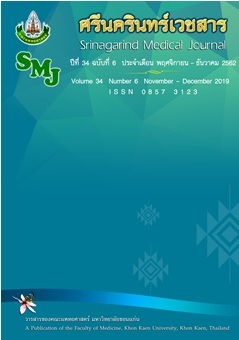Anti-Hemorrhoidal Activity of Pluchea indica Leaves Aqueous Extract in Croton Oil-Induced Hemorrhoids in Experimental Animals
Keywords:
Pluchea indica; whole gut transit time; intestinal transit rate; hemorrhoids; experimental animals, ขลู่; เวลาในการขนส่งทั้งหมดของลำไส้; อัตราการขนส่งในลำไส้; ริดสีดวงทวาร; สัตว์ทดลองAbstract
Background and Objective: Pluchea indica (L.) Less (“Khlu” in Thai) is traditionally used as a folk medicine for the treatment of many diseases and Pluchea indica leaves tea is quite famous and used to help cure hemorrhoids without any scientific evidences. This study focuses on the investigation of the effects of aqueous extract of Pluchea indica leaves on the movement of gastrointestinal tract in mice and the croton oil-induced hemorrhoid in rats.
Methods: The effects of Pluchea indica leaves aqueous extract (PIE) at the doses of 50, 100 or 150 mg/kg on whole gut transit time and intestinal transit rate in male ICR mice were tested using the charcoal test. Male Wistar rats were forced fed with PIE at 50 mg/kg/day once daily for 10 consecutive days. On day 5, the animals were induced to be hemorrhoids by inserted cotton bud swab soaked with cotton oil preparation (100 μl) into the anus. Rats were killed on day 11, anus and spleens are removed and weighed and macroscopic changes of the rectum were observed.
Results: Oral administration of PIE at either 50, 100 or 150 mg/kg had no effect on whole gut transit time or intestinal transit rate in mice. PIE at 50 mg/kg/day could significantly attenuate the severity of the croton oil-induced hemorrhoids in rats as seen by a significant reduction of spleen and rectum weights and the severity of the rectal damage was significantly reduced.
Conclusions: The result of this study supported the effectiveness of the traditional use of Pluchea indica leaves tea in the treatment of hemorrhoids. However, at the doses tested, no effect on the gastrointestinal movement was seen.
References
2. Odukoya OA, Sofidiya MO, Ilori OO, GbededoMO, Ajadotuigwe JO, Olaleye OO. Hemorrhoid Therapy with Medicinal Plants: Astringency and Inhibition of Lipid Peroxidation as Key Factors. Int J Biol Chemi 2009; 3: 111-8.
3. Chauhan R, Ruby K, Dwivedi J. Antioxidant, lipid peroxidation and astringency study of hydroethanolic root extracts of Bergenia ligulata, Bergenia ciliata and Bergenia stracheyi. Eur J Medicinal Plants 2016; 15: 1-10.
4. Suriyaphan O. Nutrition, Health Benefits and Applications of Pluchea indica (L.) Less Leaves. Mahidol University Journal of Pharmaceutical Sciences 2014; 41: 1-10.
5. Andarwulan N, Batari R, Sandrasari DA, Bolling B, Wijaya H. Flavonoid content and antioxidant activity of vegetables from Indonesia. Food Chem 2010; 121: 1231-5.
6. Yuliani Y, Soemarno, Yanuwiadi B, Leksono A. Total phenolic and flavonoid contents of Pluchea indica Less leaves extracts from some altitude habitats. Int J ChemTech Res 2015; 8: 1618-25.
7. Buapool D, Mongkol N, Chantimal J, Roytrakul S, Srisook E, Srisook K. Molecular mechanism of anti-inflammatory activity of Pluchea indica leaves in macrophages RAW 264.7 and its action in animal models of inflammation. J Ethnopharmacol 2013; 146: 495-504.
8. Sirichaiwetchakoon K, Lowe GM, Thumanu K, Eumkeb K. The Effect of Pluchea indica (L.) Less. Tea on Adipogenesis in 3T3-L1 Adipocytes and Lipase Activity. Evid Based Complement Alternat Med 2018 ; 2018: 4108787. doi: 10.1155/2018/4108787. eCollection 2018.
9. Abramowitz L, Godeberge P, Staumont G, Soudan D. Clinical practice guidelines for the treatment of hemorrhoid disease. Gastroenterol Clin Biol 2001; 25: 674-702.
10. Gupta PJ. The efficacy of Euphorbia prostrata in early grades of symptomatic hemorrhoids –a pilot study. Eur Rev Med Pharmacol Sci 2011; 15: 199-203.




